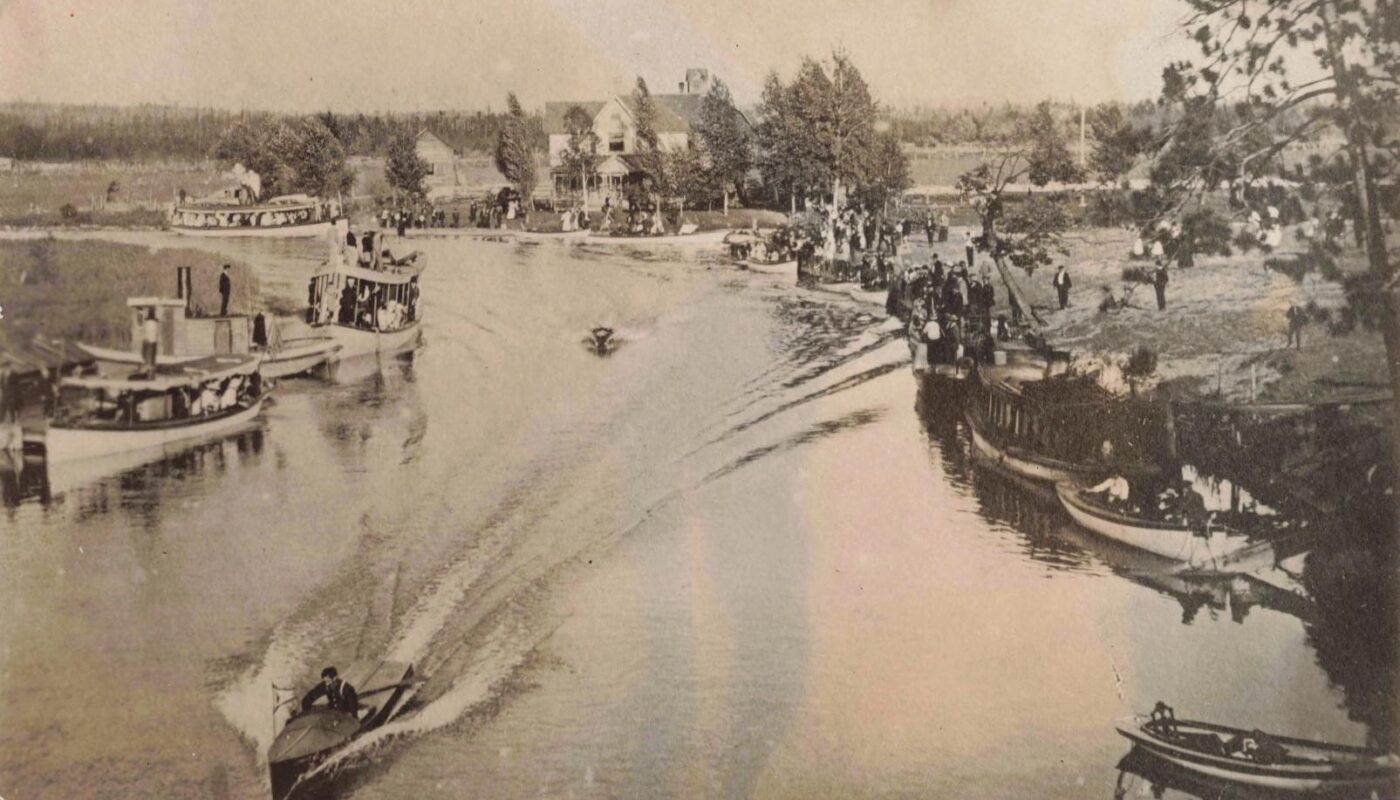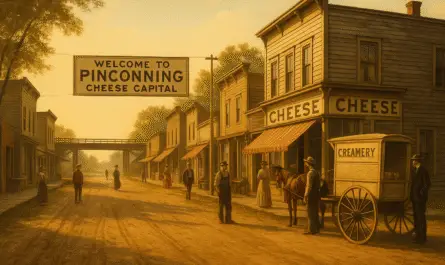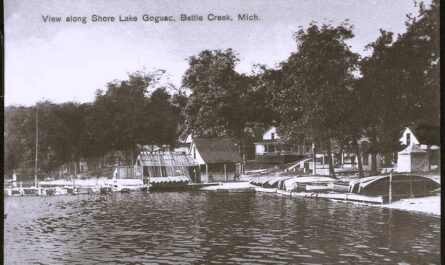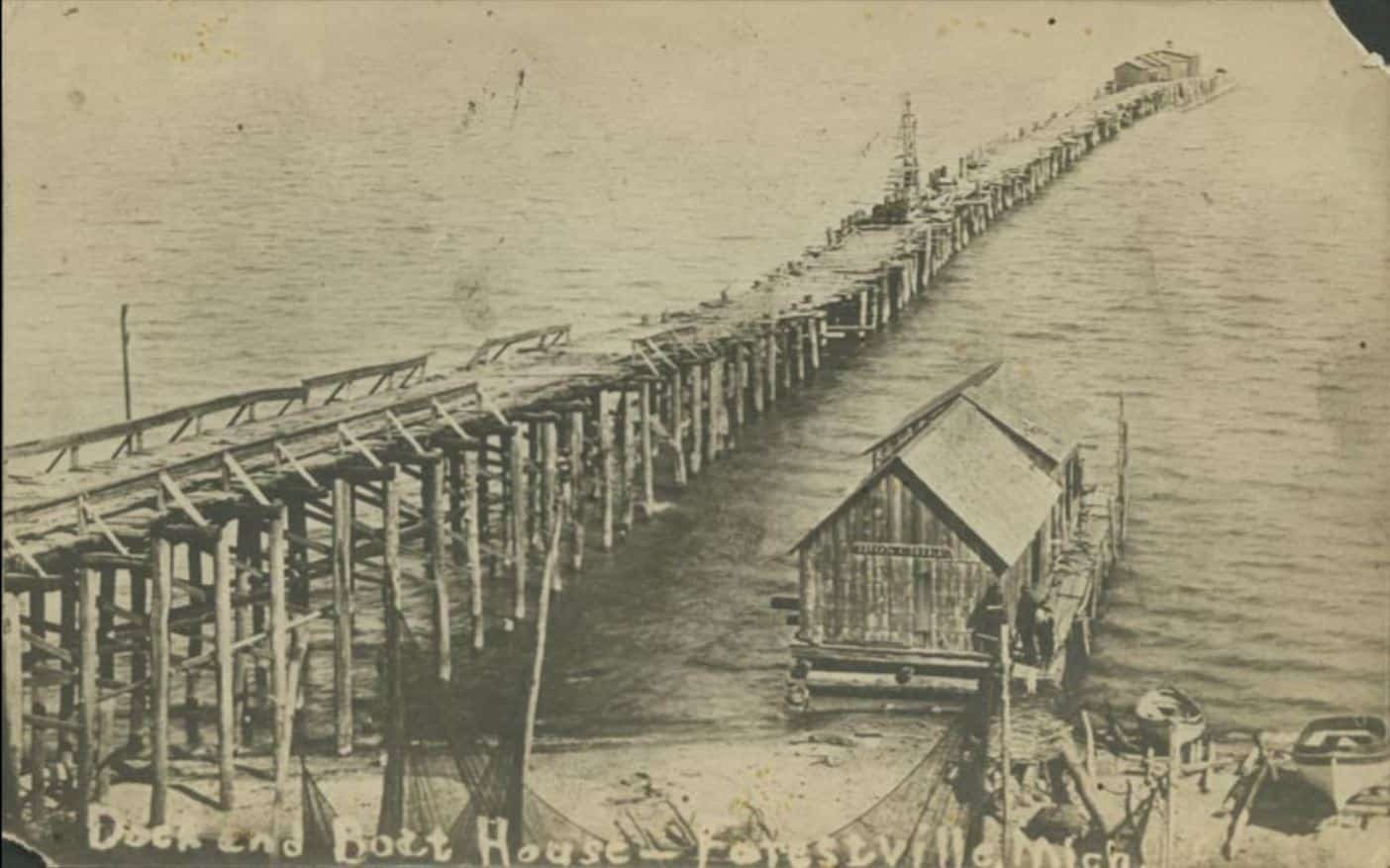Northern Michigan’s Michigan Inland Waterway links Crooked Lake to Lake Huron by way of the Crooked, Indian, and Cheboygan rivers and two major lakes, Burt and Mullett. Once a working route for logs, freight, and excursion steamers, it is now a recreational chain where history sits in plain view—at locks, depots, parks, and old resort sites from Conway to Cheboygan.
Table of Contents
Why the Michigan Inland Waterway mattered
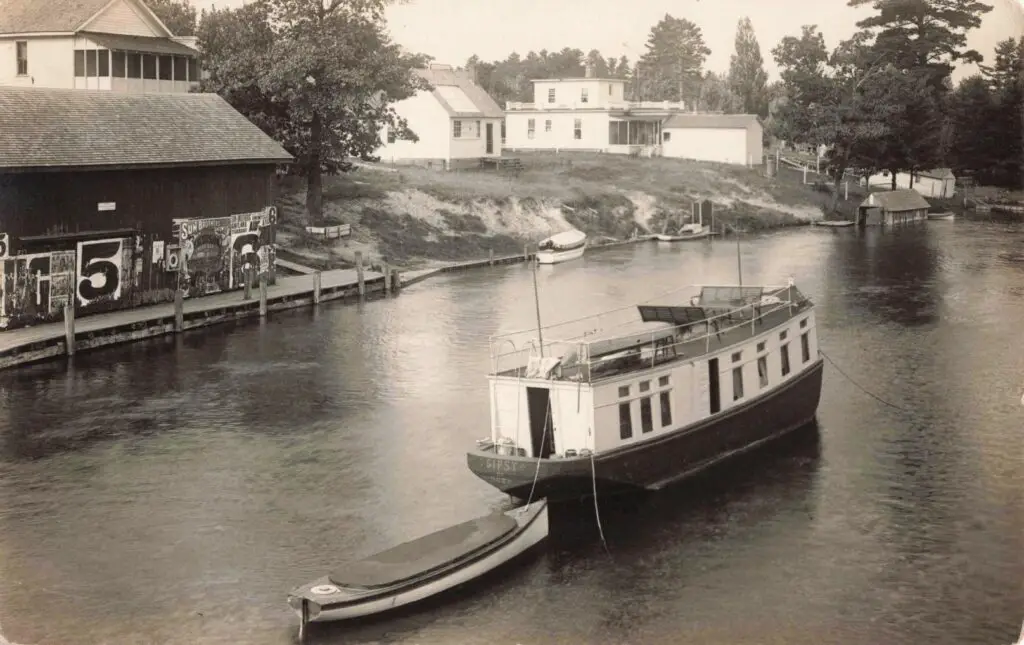
The route offered a sheltered alternative to the open Straits. A lock at Cheboygan (1869) opened commercial passage for the Cheboygan Slack Water Navigation Company, while dredging campaigns in the 1870s kept channels usable. In 1877, engineers even rerouted the Sturgeon River to reduce sandbars at Indian River. The modern Crooked River Lock at Alanson (1969) stabilized levels and restored seamless travel on the west end.
Waterway Timeline
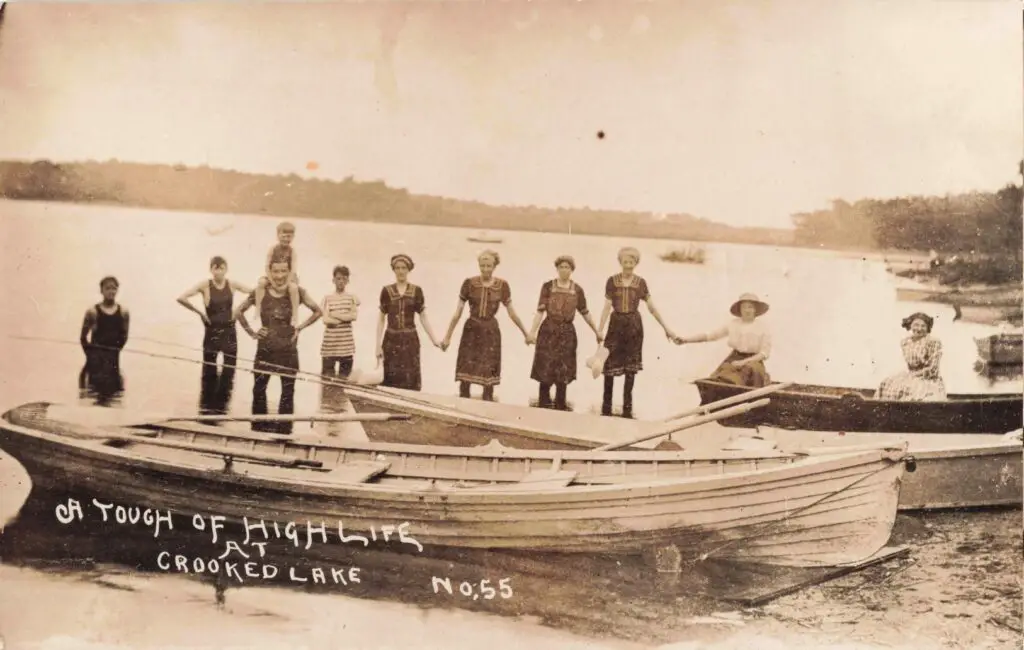
- Pre-rail era: Indigenous travelers and early traders used the connected waters and a short portage near Little Traverse Bay.
- 1869: Cheboygan lock opens; commercial freight and passengers surge.
- 1870s: Dredging begins; Sturgeon River diversion completed in 1877.
- 1890s–1910s: Railroads meet launches and steamers; resorts expand.
- 1920–23: Burt Lake State Park (1920/1921) and Aloha State Park (1923) anchor public access.
- 1969: Crooked River Lock opens in its modern form.
Town-by-town: History, Players and what Remains
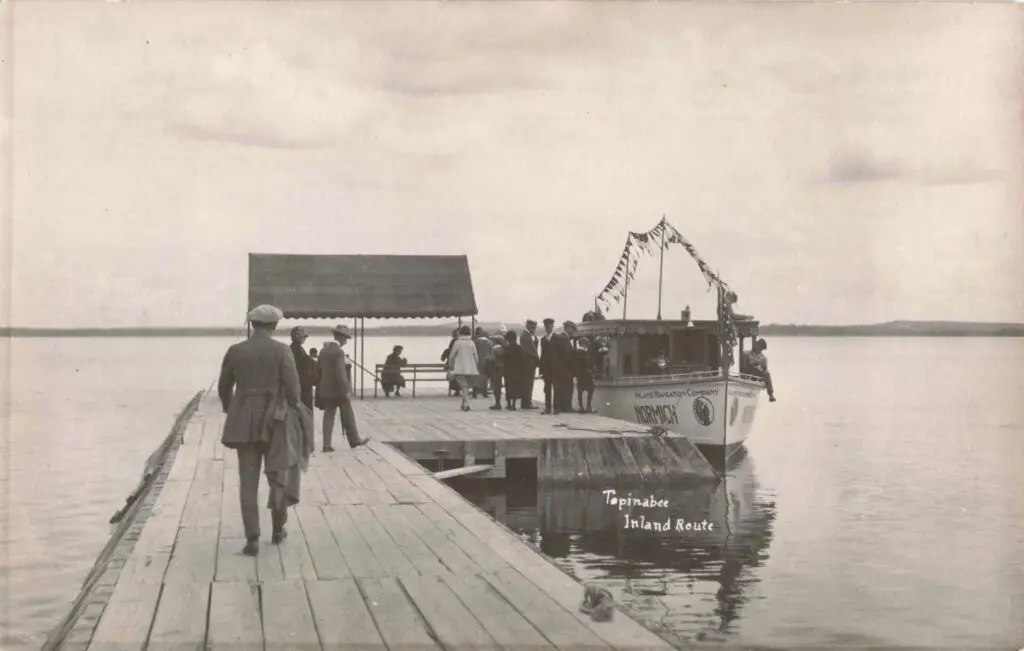
Conway
At the head of Crooked Lake, Conway cycled through names—Crooked Lake, Dodge’s Landing (1881), and Conway (1882)—as the GR&I Railroad made it a transfer point between rail and boats. Cottage life grew with the rail stop, setting the tone for seasonal travel on the west end of the waterway.
Oden
Oden became a resort embarkation point where visitors stepped off morning trains to board steamers on Crooked Lake. The state opened the Oden State Fish Hatchery in 1921; today its visitor center interprets the region’s fisheries story and the old rail-to-boat connection.
Alanson
Alanson sits at the Crooked River pinch point. The Crooked River Lock manages levels and passage between Crooked Lake and Burt Lake; it is 60 feet by 17 feet and lowers boats only inches depending on water conditions. The U.S. Army Corps of Engineers owns the lock, leasing it to the Michigan DNR; Emmet County operates it. Nearby, the Alanson swing bridge is widely billed as one of the smallest operating swing bridges, a nod to the compact scale of navigation here.
Burt Lake
Named for surveyor William Austin Burt, Burt Lake sits at the system’s center. Public access expanded with the establishment of Burt Lake State Park (1920/1921), aiding the region’s pivot from logging to tourism. Any full history should also reckon with the 1900 Burt Lake Burn-Out, a forced eviction and burning of the Burt Lake Band’s village—a documented chapter of dispossession that shaped land ownership around the lake.
Burt Lake Scenic Tower
A roadside observation tower once stood near Indian River, drawing motorists with paid views over Burt Lake and the Inland Waterway. The deck featured a Carl Zeiss 42× telescope, a novelty that let visitors scan the lake, river, and resort shoreline from a fixed platform. The tower was popular through the interwar years and faded after World War II; by the 1960s, it was gone. Today, an overgrown overlook linked to Burt Lake State Park marks the approximate site.
Indian River
Where water from Burt Lake funnels toward Mullett, Indian River became the route’s mid-corridor town. Federal and state projects widened channels and, in 1877, diverted the Sturgeon River to reduce sand deposits that clogged navigation—an early engineering fix still visible on maps.
Topinabee
Platted as a resort in 1881–82 with the Michigan Central line, Topinabee took the name of a Potawatomi leader and quickly marketed lake life to rail travelers. The depot and hotels helped make Mullett’s west shore a reliable pause for excursion steamers and cottage goers.
Steamer Topinabee
The Topinabee was the Inland Waterway’s best-known excursion steamer. Shallow-draft and double-decked, it linked rail stops to lakeside hotels and docks from Oden to Cheboygan, with a dinner hour scheduled at Topinabee on Mullett Lake. Typical trips started in Oden, paused at Alanson and Indian River, then continued to Topinabee and Cheboygan; on some runs, service extended to Mackinac Island. A.L. Hamill often captained the boat and aggressively promoted the runs.
Mullett Lake
Mullett Lake honors surveyor John Mullett, Burt’s colleague in the 1840–43 federal surveys. At the Cheboygan River mouth sits the Hack-Ma-Tack Inn (1894), which began as a hunting and fishing lodge and later became a classic boater stop—an emblem of how the corridor shifted to leisure.
Aloha
Aloha started as a mill hamlet and Detroit & Mackinac Railway stop, with a post office (1903–1942). Aloha State Park followed in 1923 after county-to-state land transfers tied to the old railroad property, placing public camping and a boat basin at the center of the route.
Cheboygan
At the Lake Huron outlet, Cheboygan’s 1869 lock turned a working river into a regional artery for logs and freight. Lumbering’s scale here left lasting images—most notably the “world’s largest sawdust pile,” reported at roughly 50 feet high and covering about 10–12 acres—before industry waned and pleasure boating took over.
Locks, dredges, rules: how the system works now
Two locks make the Michigan Inland Waterway navigable end-to-end for small craft. The Cheboygan River Lock connects the corridor to Lake Huron; the Crooked River Lock governs levels and passage on the west end. The corridor is maintained to a designed recreational depth through routine dredging, and federal rules set Crooked River Lock operating dimensions and procedures. Local agencies post seasonal schedules and fees.
If you go
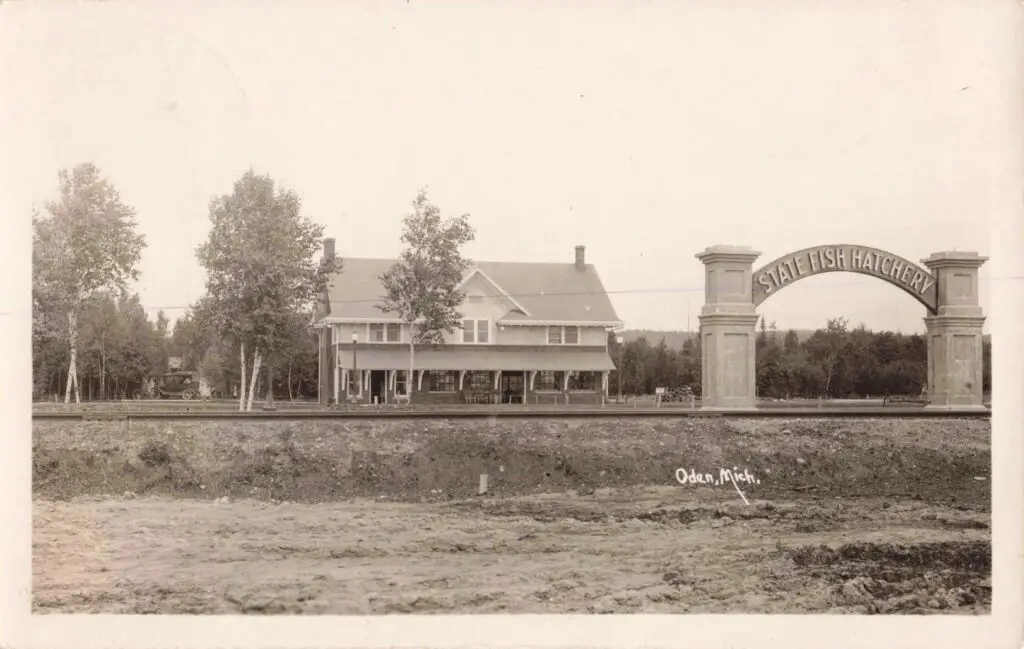
- Museums/centers: Inland Water Route Historical Museum (Alanson); Oden State Fish Hatchery Visitor Center.
- State parks: Burt Lake (Indian River) and Aloha (Mullett Lake) offer shoreline access and camping tied to the historic route.
- Locks: Check the Crooked River Lock and Cheboygan Lock pages for seasonal operations, dimensions, and contact info.
Reference Notes (verification anchors)
- Cheboygan lock opening in 1869; Sturgeon River 1877 diversion; multi-decade dredging: state planning documents and historical PDFs.
- Crooked River Lock ownership/operation and dimensions: USACE/DNR/Emmet County pages and federal regulations.
- Conway/Oden early rail-to-boat patterns: Inland Water Route Historical Society.
- Burt/Mullett naming and park dates: DNR and lake history references. Michigan+1
- Cheboygan sawdust pile scale (contextual, not official superlative): local historical reporting.
